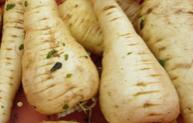Parsnips

Growing Parsnips
Varieties
Gladiator, Arrow, Javelin, Albion.
See your seed dealer for the most recent variety recommendations.
Seed treatment
For control of damping off and seedling blight caused by Pythium spp., Fusarium spp. and Rhizoctonia spp., use seed treated with Apron MAXX RTA.
Seeding and spacing
Sow seed as early in the spring as possible at a rate of 3.25 to 5.5 kg/ha (1.3 to 2.2 kg/acre), to a depth of 6 to 19 mm. Space plants within the row 5 to 10 cm apart and space rows at least 45 cm apart.
Soil
Deep, loose fertile soils that have good water-holding capacity and a pH of 6.0 or above are necessary for the development of long, straight roots. Well-drained sandy loams, peat and mucks are ideal for parsnip production.
Fertilizer
A soil test is necessary to determine phosphate and potash requirements. Use the Vegetable Production Guide: Nutrient Management (PDF) for recommendations based on soil test results. Broadcast and disc at time of planting 60 kg/ha (24 kg/acre) nitrogen and the required phosphate and potash.
Side-dress with 35 kg/ha (14 kg/acre) of nitrogen about 6 weeks after seeding.
Parsnip weed management
Pre-plant Incorporated
| Product | Rate | PHI* | Comments |
|---|---|---|---|
Edge(ethalfluralin) |
17 to 28 kg/ha (6.9 to 11.3 kg/acre) |
N/A |
|
*PHI = Pre-harvest interval
BUFFERS – Refer to product label for buffer requirements, and consult the Vegetable Production Guide: Pesticide Regulations and Safety (PDF).
PESTICIDE GROUP DETAILS – see the Vegetable Production Guide: Pesticide Toxicity Table (PDF).
Pre-emergence
| Product | Rate | PHI* | Comments |
|---|---|---|---|
Lorox L(linuron)
Group 7 |
Loam or clay soils with low organic matter: 1.3 to 1.9 L/ha (520 to 760 mL/acre) Muck or clay soils with med. organic matter: 1.9 to 2.5 L/ha (0.76 to 1.0 L/acre) |
60 |
|
Dual II Magnum(S - metolachlor)
Group 15 |
Mineral soils:
1.2 to 1.5 L/ ha
(500 mL to 600 mL/ acre)
Muck soils (>20% OM):
1.5 to 1.75 L/ ha
(600 to 708 mL/ acre)
Apply in 150 to 300 L/ha (60 to 120 L/acre) of water at 200 to 300 kPa
|
60 |
|
*PHI = Pre-harvest interval
BUFFERS – Refer to product label for buffer requirements, and consult the Vegetable Production Guide: Pesticide Regulations and Safety (PDF).
PESTICIDE GROUP DETAILS – see the Vegetable Production Guide: Pesticide Toxicity Table (PDF).
Post-emergence
| Product | Rate | PHI* | Comments |
|---|---|---|---|
Select(clethodim)
Group 1
|
0.19 to 0.38 L/ha (75 to 155 mL/acre) Apply in 110 L/ha (45 L/acre) of water at 275 kPa |
30 |
|
Centurion(clethodim)
Group 1
|
0.19 to 0.38 L/ha (75 to 155 mL/acre) Apply in 110 L/ha (45 L/acre) of water at 275 kPa |
30 |
|
Lorox L(linuron)
Group 7 |
1.9 to 2.5 L/ha (0.7 to 1.0 L/acre) Apply in 220 to 440 L/ha (90 to 175 L/acre) of water at 275 kPa |
60 |
|
Aim EC(carfentrazone-ethyl)
Group 14
|
37 to 117 mL/ha (15 to 47 mL/acre) Apply in 100 L/ha (40 L/acre) of water |
1 |
|
Dual II Magnum(S - metolachlor)
Group 15 |
Mineral soils:
1.2 to 1.5 L/ ha
(500 mL to 600 mL/ acre)
Apply in 150 to 300 L/ha (60 to 120 L/acre) of water at 200 to 300 kPa
|
60 |
|
*PHI = Pre-harvest interval
BUFFERS – Refer to product label for buffer requirements, and consult the Vegetable Production Guide: Pesticide Regulations and Safety (PDF).
PESTICIDE GROUP DETAILS – see the Vegetable Production Guide: Pesticide Toxicity Table (PDF).
Parsnip insect management
Carrot rust fly (carrot maggot)
This small, shiny, black fly with yellowish legs and yellow-brown head, lays eggs in soil near plants. Yellowish-white, legless maggots feed on roots of carrots, parsnips and celery, leaving rust-coloured tunnels. Young plants may be killed. Older plants may be stunted and the roots deformed.
Note: there is currently nothing registered in Canada for carrot rust fly.
Parsnip disease management
Canker
At least two fungi cause canker on parsnip: Itersonilia and Phoma.These diseases are very common in wet seasons, causing a leaf spot on the foliage and a rusty brown to black decay of the roots. Root infection usually begins at the crown or at points where carrot rust fly larvae have wounded the root.
Control
- Gladiator is the most resistant variety recommended in B.C. In Ontario, Andover is said to be resistant to both Itersonilia and Phoma canker.
- Rotate crops. Do not replant parsnips for at least one year after a canker-infected crop has been grown.
- The leaf spot phase may be quite destructive to the foliage under wet conditions. A fungicide spray program such as that used for foliar blights of carrots will reduce damage. See table below for instructions.
- The leaf spot phase may be an important source of inoculum for the exposed shoulders of the roots under conditions of frequent rainfall or irrigation. Hilling the shoulders with soil will reduce the number of infections.
- Carrot rust fly wounds may be followed by canker infection. These infections can be prevented by closer attention to rust fly control.
| Product | Rate | PHI* | Comments |
|---|---|---|---|
Bravo 720(chlorothalonil)Group M5 |
1.9 L/ha (0.8 L/ac) |
7 |
|
Bravo ZN(chlorothalonil)Group M5 |
2.8 L/ha (1.1 L/acre) | 7 |
|
Bravo ZNC(chlorothalonil)Group M5 |
|||
Echo 720(chlorothalonil)Group M5 |
1.9 kg/ha (0.60.8 kg/ac) | 7 |
|
*PHI = Pre-harvest interval
BUFFERS – Refer to product label for buffer requirements, and consult the Vegetable Production Guide: Pesticide Regulations and Safety (PDF).
PESTICIDE GROUP DETAILS – see the Vegetable Production Guide: Pesticide Toxicity Table (PDF).
